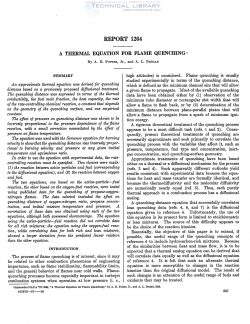naca-report-1264
- Version
- 139 Downloads
- 581.30 KB File Size
- 1 File Count
- November 2, 2016 Create Date
- November 2, 2016 Last Updated
National Advisory Committee for Aeronautics, Report - A Thermal Equation for Flame Quenching

An, approximate thermal equation was derived for quenching
distance based on a previously proposed diflusional treatment.
The quenching distance was expressed in terms of the thermal
conductivity, the fuel mole fraction, the heat capacity, the rate
of the rate-controlling chemical reaction, a constant that depends
on the geometry of the quenching surface, and one empirical
constant.
The eject of pressure on quenching distance was shown to be
inversely proportional to the pressure dependence of the flame
reaction, with a small correction necessitated by the efiect of
pressure on flame temperature.
The equationwas used with the Sentence equation for burning
velocity to show that the quenching distance was inversely propor—
tional to burning velocity and pressure at any given initial
temperature and equivalence ratio.
In order to use the equation with experimental data, the rate-
controlling reaction must be specified. Two choices were made:
(1) the reaction between active particles and fuel (corresponding
to the difiusional equation), and (2) the reaction between oxygen
and fuel.
The two equations, one based on the actioe—particle—fuel
reaction, the other based on the oxygen-fuel reaction, were tested
using published data for the quenching of propane-oxygen-
nitrogen flames. The data selected included the efect on
quenching distance of oxygenmitrogen ratio, propane 007100711-
tration, and initial mixture temperature and pressure. A
correlation of these data was obtained using each of the two
equations, although both possessed shortcomings. The equation
using the active-particle—juel reaction did not correlate data
for all rich mixtures; the equation using the oxygen-fuel reac-
tion, while correlating data for both rich and lean mixtures,
showed a larger deviation from the predicted linear relation
than the other equation.
The process of flame quenching is of interest, since it may
be related to other combustion phenomena of engineering
importance, such as flame stabilization, flammability limits,
and the general behavior of flames near cold walls. Flame-
quenching processes become especially important in turboj et
combustion systems when operation at low pressure
| File | Action |
|---|---|
| naca-report-1264 A Thermal Equation for Flame Quenching.pdf | Download |

Comment On This Post